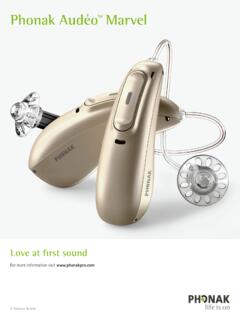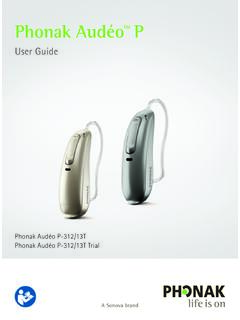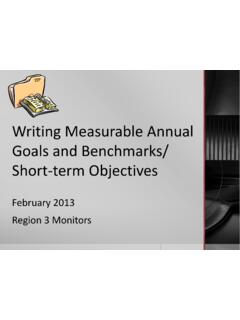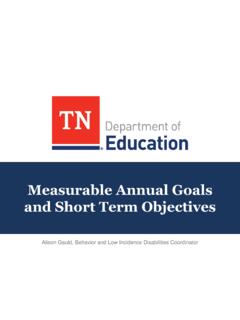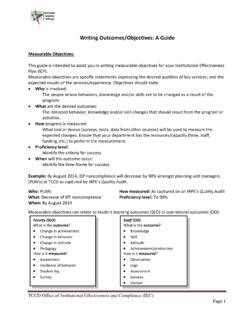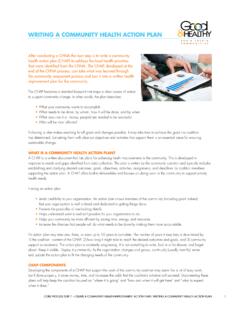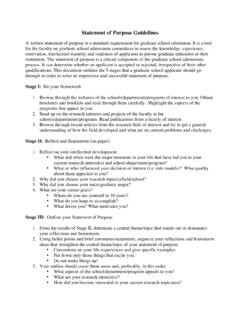Transcription of Sample IEP Goals and Learning Objectives for GAP
1 1 Sample IEP Goals and Learning Objectives for GAP It is important to align IEP Goals with relevant state content standards or the Common Core State Standards (June 2010) A portrait of students who meet the standards that are set forth in this document suggests that students who are college and career ready in reading, writing , speaking, listening, and language are able to exhibit the following capacities as a literate individual : They demonstrate independence. They build strong content knowledge. They respond to the varying demands of audience, task, purpose, and discipline. They comprehend as well as critique. They value evidence. They use technology and digital media strategically and capable. They come to understand other perspectives and cultures (p. 7).IEP Goals for high school students may include all areas of the content standards (reading, writing , speaking, listening, and language).
2 When getting started, however, the speaking and listening standards are an important place to start. Some Sample IEP Goals which are aligned to content standards illustrates how this works. (Note: The Objectives below need to be expanded in the SMART goal format based on the individual needs of each student (Specific, Measureable, Attainable, Realistic, Time ordered). Functional Performance The student s inability to hear speech the same as typical peers diminishes his/her ability to achieve grade level standards. Content Standard (from Speaking and Listening Standards 6-12, Comprehension and Collaboration-Grades 6 students) Engage effectively in a range of collaborative discussions (one-on-one, in groups, and teacher-led) with diverse partners on grade 6 topics, texts, and issues, building on others ideas and expressing their own clearly.)
3 Personal Health Info rmation and Self Adv ocacy Goal: [Student] understands communication barriers that occur in discussions in the academic setting/work setting as a result of his/her hearing loss. Objective: [Student] will actively participate in all communication discourse in the classroom. 2 With support, [student] will learn about the type and degree of hearing loss and relate toeffective auditory access in the classroom/work environment (Resources: Gap/Hearing Loss) With support, [student] will identify his/her personal implications of hearing loss in theclassroom. (Resources: Gap/Hearing Loss/Consequences of Hearing Loss) With support, [student] will identify two strategies that can be used to enhance communicationin the classroom ( using FM system, flexible seating, CART, Smart Board notes) and use thestrategies in the classroom.
4 (Resources: Gap/Technology or Gap/Self Advocacy) With support, [student] will inservice his/her teachers about hearing loss, personal limitations,hearing technology, and accommodations for the classroom. (Resources: Gap/SelfAdvocacy/Accommodations Letter) [Student] will maintain a personal hearing health notebook to include: contact information ofear specialist and audiologist, audiogram/hearing test results, type of equipment ( includingmanufacturer, model, warranties, battery information), educational programming(504/IEP/Accommodation Plans), and any other pertinent information. (Resources:Gap/Resources/Tips/Finding Services After High School)Self A dvo cacy Goal: [Student] employs self-monitoring and self-advocacy strategies to engage effectively in a range of collaborative discussions.
5 Objective 1: [Student] will decrease reliance on parent advocacy while increasing use of self-advocacy by assuming responsibility for planning and decision making. Objective2: [Student] will use self-advocacy procedures during the IEP conference. With support, [student] will identify areas of need for self-advocacy by completing the SelfAdvocacy Competency Checklist. (Resource: Gap/Self Advocacy/Self Advocacy checklist) With support, [student] will develop and verbally/sign rehearse a script for disclosing hearingloss information and required accommodations during the first grading period with 100%accuracy. (Resources: Gap/Self Advocacy/Accommodations Letter) After mastering verbal rehearsal, [student] will demonstrate application of the strategies byrole-playing a simulated IEP conference.
6 The role-plays should be recorded and reviewed by theteacher and student. The teacher gives feedback on each of the student's responses during theplayback. Students should make at least three positive, relevant responses during a role-playsession in order to have reached mastery. (Resources: Gap/Self Advocacy/AccommodationsLetter or Gap/Self Advocacy/College/Talking to my Professors) With support, [student] will discuss the Personal Profile and Accommodations Letter (PPAL) withhis/her instructor during the second grading period. (Resources: Gap/Self-Advocacy/Accommodations letter)3 With support, [student] will identify how his/her personal FM system integrates in class andcommunity activities and demonstrate how he/she may use the device in appropriate situationsduring the third grading period.
7 (Resources: Gap/Technology) Though out the day, when presented with a variety of grade level assignments, [student] willidentify the academic and hearing assistive technology (HAT) supports that he/she needs for fullparticipation in 4 out of 5 random samples. (Resources: Gap/Technology and Gap/SelfAdvocacy) [Student] will seek assistance when he/she has not received the entire message in theclassroom. [Student] will identify strategies for asking for clarification, explanation, or need for an exampleto be presented when he/she does not understand a comment, direction, or As si stance Technology Goal: [Student] uses personal hearing instruments and HAT independently to access auditory information necessary to achieve grade level standards in the classroom. Objective: [Student] will demonstrate independent use of personal hearing instruments and HAT (Resources: GAP).
8 With assistance, [student] will learn care, use, and limitations of HAT for the classroom. [Student] will independently maintain the HAT system ( , charge battery, clear equipment,store equipment at designated area). [Student] will transport HAT from class to class. [Student] will identify a malfunctioning system and notify the teacher when the equipment isnot turned on or malfunctioning. [Student] will use the HAT during his/her classes which will be measured bychecklists/observation of teachers. With assistance, [student] will identify and couple HAT to two external audio devices to assistwith Learning in the classroom ( ,TV, computer, Smart Board, phone) [Student] will participate in hearing and hearing assistive technology monitoring by to Work/C ollege Goal: [Student] understands his/her hearing loss and its effect on communication in order to develop strategies and accommodations to address workplace/college barriers.
9 Objective: [Student] will continue to develop more independent work habits and age appropriate social skills. [Student] will have auditory/visual access to presentations in large group settings and [Student] will develop independence in his/her self-care skills. (Resources: Gap/Assessments/MyGap Transition Checklist and My Gap Self-Assessment) [Student] will participate in mock interviews for work/college and address communicationbarriers due to hearing loss. (Resources: GAP/Self Advocacy/College materials) [Student] will identify issues related to hearing loss and obtaining a driver s license. The studentwill complete the Hearing Loss Notification Card prior to obtaining his/her driver s license.(Resources: Gap/Activities/Hearing Loss Notification Card) [Student] will identify potential workplace barriers and possible solutions as a result of his/herhearing loss.
10 (Resources: Gap/Self Advocacy/Employment/10 Common Workplace Barriers/10 Workplace Solutions)Right s of Students w i th Hearing Los s Goal: [Student] understands the legal rights for individuals with disabilities and hearing loss and applies them to his/her situation. Objective: [Student] will identify pertinent laws that impact individuals with disabilities and hearing loss, explain their implications, and apply them in appropriate situations. [Student] will identify the differences between Section 504, IDEA, and ADA in order to advocatefor appropriate accommodations in high school/work setting/college. (Resources:Gap/Information) [Student] will review the Postsecondary Program Interview Accommodations AvailabilityChecklist in GAP (under Information) and identify potential services needed in the followingareas: In classroom and out of classroom support services, communication facilitation, andpersonal and school equipment requirements.
